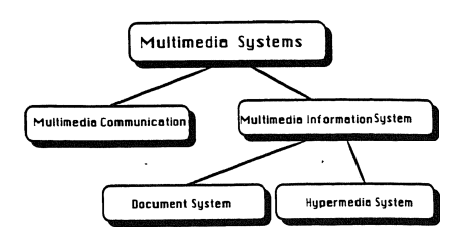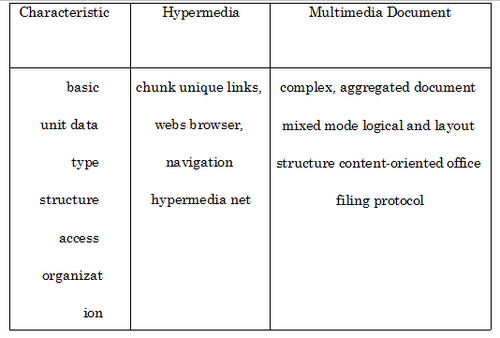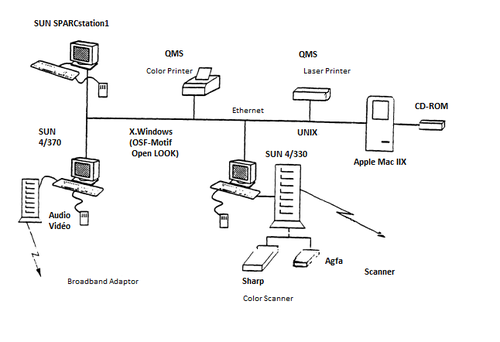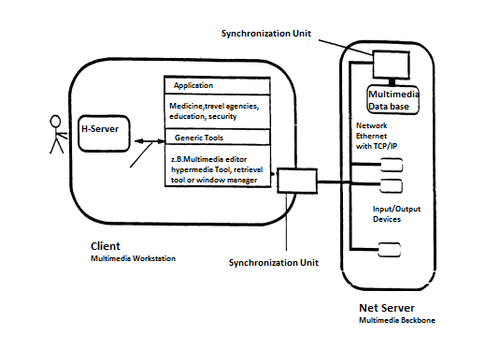H2PTM (1989) Cordes
On the Way to hypermedia and multimedia Services and Terminals
|
Sommaire
- Abstract
- To manage all kinds of data, including text, formated data, still image, graphic, voice and animation in a computer network is one of the main challenges in computer science and also in telecommunication research. We call those systems multimedia information systems. In this paper we will outline some basic requirements concerning technical issues of multimedia workstations serving as intelligent terminals for broadban communication as well as conceptual and information retrieval techniques for multimedia systems (hyperdmedia techniques) and services. In the department Services and terminals of TELENORAMA's Advanced development we design and develop basic for future office applications and services. Main goal is the design and development of multimedia workstations, multimedia document transfer tools, and multimedia/hypermedia retrieval tools. This paper gives also an overview of the current department activities concerning office broadband services.
Introduction
1 Introduction To manage all kinds of data, including text, formatted data, still image, graphic, voice, video, and animation in a computer network is one of the main challenges in computer science and also in telecommunication research. We call those systems multimedia information systems. They are under development in many places or exist as prototypes [1,4,8,9,10,12,13,14.27,34,36]. The starting point of all those systems has been a multimedia message handling system introduced by [33]. One goal of the following phase of multimedia systems has been the handling of electronic books [6,14,25,35]. Nowadays, there are big projects in different fields of multimedia information processing [2,10,11,23] carrying out new features and processing functionalities and there are special labs launching multimedia services [2,3,15,22,26].
we will outline some basic requierements concerning technical issues of mul-multtimedia workstations serving as intelligent terminals for broadband communication as well as conceptual and information retrieval techniques for multimedia systems and services. Doing this we will acknowledge current standardization activities as well as present a prototype of such system which has been developed in a former research group at the University of Braunschweig. Moreover we present first results from TELENORMA’s activities in this field.
Multimedia and Hypermedia Systems
In Figure 1 we give a rough classification of multimedia systems.
Multimedia Communication Systems are providing communication-oriented features like videotelephony, videoconferencing or even videotex and telephony. These systems need broadband facilities, audio and video switches
and various technical equipment like cameras, special terminals or displays. Examples of those systems we find in Bellcore’s IMAL (Integrated Media Architecture Laboratory) [22] or in the US-West Collaborative Work Trial [3]. Wide area prototypes are known from the German BerKom project [28] and in Europe the RACE programme launches broadband research and development [30].
Multimedia Information Systems are offering paper-oriented features like handling and transfer of structured multimedia documents, storing of multimedia information and access to multimedia chunks of information. Looking at multimedia information systems we distinguish between hypermedia systems and multimedia document systems.
Figure 2 summarizes the characteristics of multimedia information systems and shows the differences between hypermedia and multimedia document systems.
In a multimedia document system we find complex multimedia documents, which normally are aggregations of components of different types; e. g. image, text, and graphic components. Moreover, we find hierarchical, logical, and layout structures for those documents. In most cases, multimedia document systems offer content-oriented access features, but mostly these systems define no relationships among the stored documents. Special attributes belonging to every particular document are kept in a document profile. Examples for those are [4,8,9,14,18,19,34].
A chunk of information without any logical structure is the typical basic object in a hypermedia system. These chunks are connected by various links representing different kinds of semantical relationships. Those links serve as the mam access feature of hypermedia systems supporting navigation and browsing. So, the overall architecture of such a system is the typical hyperme-dia network. Examples we find in [1,12,17,35,36].
Systems which combine hypermedia techniques with document handling features are described in [6] and [25].
MuBIS — A Multimedia Document Server for Office Applications
During the period 19S5 to 1988 a prototype of a multimedia document server has been designed and implemented at the Technische Universität Braun-schweig [4,5,21].
The following issues are characterizing the system called MuBIS (Multimedia Bureau Information System):
- MuBIS provides an universal system architecture supporting various of-fice information applications.
- MuBIS manages large and complex objects like documents. These objects are divided into basic chunks in order to
- avoid large unstructured chunks of information,
- allow simple extraction of components,
- support different modes for object handling,
- connect dedicated tools with special object components, and
- store components only once, even if they part of many objects.
- Presentation, description, and representation of multimedia information is possible.
- New technologies of laser-optical disks are integrated into MuBIS.
To meet some of the mentioned requirements of multimedia information systems we have drafted a layered and module oriented software architecture embedded in MS-DOS for the prototype system MvBIS-Pro (see Figure 3).
In that architecture primarily three layers exist:
- an application system.
- the data management system and
- the peripherals.
The application system provides, aside from a common multimedia user interface with an integrated help facility, the following multimedia processing tools:
- a multimedia editor (for text, image and graphics).
- an indexing and query processing facility (IQP) and
- a tiny multimedia dialogue manager.
The data management organizes the logical and physical data organization. while the peripheral layer offers some primitives for connecting devices like laser-optical disks, scanner, or printer.
The hardware platform consists of:
- a Nixdorf PWS-D (personal computer with DOS),
- a LED page printer (NEC LC-815),
- a CCD-Scanner (Ricoh SS30).
- a CD-ROM drive (Sony CDU-200),
- a controller for laser-optical disks (Sony WDC-2000),
- a laser-optical WORM-drive (Sony WDD-2000).
Intermedia
Intermedia [35] [36] is a general hypermedia system to support education. It handles data types like text, graphics, bitmaps, 3-D images, music, and video on a second terminal. Intermedia supports the structuring of the multimedia data units in a hierarchical way like folders, documents, and blocks as well as in a network oriented manner like nodes, links and webs which are contexts of one particular node. Intermedia offers several tools to manipulate the different data items for authoring and browsing but it lacks the facility of communication and the consideration of international standards. It is implemented in C based on the MacApp ToolBox on an Apple Macintosh and also on IBM PC/RT running under a special derivate of Berkeley Unix 4.3.
DVI
DVI (Digital Video Interactive) [10,11,23] is a digital approach to handle all multimedia data in a random access memory. It was initiated by RCA and continued by INTEL. The DVI functionalities are implemented currently as a set of plug-in boards in an IBM PC/AT compatible computer the so called Pro750 Application Development Platform. The current system is implemented in C under Intel-Assembler. There are only few informations about the conceptual data model of DVI available, but the system supports browsing and authoring features including those like CD-ROM premastering. The system is designed as an integrated multimedia workbench based on an IBM PC. In particular this approach also lacks communication features. The approach supports standards like NTSC (PAL is in progress), RGB output for computer monitors and industrial ones like SCSI interface to CD-ROMs and the IBM PC (AT and PS/2) systems family. So the current work is done under MS/DOS, but it will also be available under OS/2.
Components of a multimedia broadband terminal
A possible hardware architecture [1] may have the following capabilities:
- There has to be a powerful workstation with a large RAM and inter-face boards and to support multimedia processing and communication functionalities.
- A high resolution colour screen (up to 4 MPixel) and high quality printing devices. Interaction requires a mouse and a keyboard as well as a tablet or touch screen capabilities. The integration of voice into the multimedia dialogue is an interesting feature.
- The workstation will serve as an IBC (Integrated Broadband Communication) terminal. Therefore special internal communication interfaces or external terminal adaptors are necessary.
- As memory expansions, like laser-optical disk drives ( WORM [2]), erasable devices (MO [3]) , CD-ROMs, video disks or giga tapes (DAT) have to be integrated.
- A colour scanner may serve for capturing pictoral information; also we may integrate a video recorder or video camera.
- access to a highspeed local area network shall be provided.
The influence of standards
In the area of multimedia and hypermedia systems we have three main types of standards supporting multimedia platforms, i. e. :
- data type specific standards for text, graphic (GKS, PHIGS,...), image (TIFF, FAX G3, ...), Video (PAL, SECAM, RGB, ...) and audio.
- data type overlapping standards for integrated handling, representation and presentation a set of different data types like ODA (Office Document Architecture), DAPA (Digital Audio and Picture Architecture [37]) or the activities inside the MHEG (Multimedia Hypermedia Expert Group) of WG8 inside the ISO-IEC JTC1 [20].
- communication related protocols and reference models. Important industrial standards are TCP/IP, NFS or X.Windows for different levels of communication. But also from ISO/OSI different activities are known, like
- ALS (Application Layer Structuring),
- DOAM (Distributed Office Application Model), or
- ODP (Open Distributed Processing).
CCITT provides DAF (Distributed Application Framework), which looks similar to the ODP model and is also supported by the ECMA as SE-ODP (Supporting Environment for ODP)
In [20] we find a model for handling live multimedia applications. This approach is more general comparing to the current ODA/ODIF model, because of their proposal for content coding of audio, video as well as for multilevel still images (especially colour maps). The ODA approach lacks these features at this time. All the described data types are discussed inside MHEG in different environments or levels. They pointed out the following main five aspects of a multimedia environment:
- the storage media: physical storage and coding of information portions
- the communication media: physical transmission media with low level protocols
- the representation media: conceptual model and logical design of multimedia information with the appertaining processing functions
- the presentation media: physical presentation of information on the different input and output devices
- the perception media: the different kinds of human perception of information to enlarge the bandwith of human interaction styles,
The main common point of the ODA approach and the MHEG activities is an object oriented model serving as a tool for conceptual design. The ap-proach supports basic objects (basics) as well as complex objects (compounds or composites).
A hypermedia and multimedia testbed
Having those standardization efforts in mind a hypermedia and multimedia testbed will be developed. The hardware and the way of connecting different devices and workstations is shown in Figure 4.
The SUN workstations will be extended towards a multimedia workstation. The design and the development of such a station will be made inside the RACE Project R1038 Multimedia Communication Processing and Representa-tion. The first outline of such a prototype has been done [24] and the different components of the station are under development at this time. Keypoints of the design of that station are the use of a UNIX operating system and X.Windows as the protocol for graphical interaction.
Moreover, we intend to define new multimedia and hypermedia services which will be available on that advanced terminal for broadband communication. Having the first results of standardization from MHEG [20] for multimedia and hypermedia in mind, we have to define multimedia processing functions, synchronization and conversion techniques for different kinds of media and to design a multimedia user interface. For this development we use the multimedia backbone which serves as an experimental platform for testing new multimedia functionalities. On a client-server architecture ( see Fig. 5 ) there axe two smaller activities dealing with
- Multimedia Document Transfer and
- Multimedia Retrieval Tools
In the development of the multimedia retrieval tool we proceed in a MHEG oriented manner. Having the MCPR object model [24] in mind we distinguish between a particle (a basic object of one particular data type) and pages (which are compound objects) in the representation layer. Between those objects different kinds of links [32] are established, i e.
- annotations links from pages to a particle.
- particle-to-page links invoke a new compound object.
particle-to-particle interlinking of basic objects.
It is also possible to browse from page to page. This first retrieval tool integrates the data types text, bi-level image and speech and has been developed under X. Windows in C++ using the Interviews toolkit on a SUN SparcStation1 under SunOS 4.0. For persistence of multimedia objects files of the Network Filing System NFS are used only. Further investigations are:
- Using a database for the persistent objects.
- Developing further retrieval techniques (e.g. browsers, indexing, ...).
- Using speech as alternate interaction style in multimedia dialogue.
- Integration of five video, multi-level image and graphics.
- Extensions of the link model.
Comparisons, Open Problems, and Conclusion
A rough comparison of the approach to handle multimedia information in a client-server architecture with some other current projects looks as follows:
- The integration of broadband communication features and the development of the appertaining boards for supporting the different interfaces providing a testbed for distributed multimedia applications and services.
- The consideration of new communication protocols like ATM (asynchronous transfer mode) for broadband communication as well as the integration of new approaches on higher layer protocols like NFS, X.WINDOWS and other features according to the ISO/OSI efforts like FTAM allowing distributed processing.
- The orientation at open system strategies and international standards. That means as operating system UNIX has been chosen and as main hardware platform SUN workstations. On the other hand we will follow the efforts in the different SCs belonging to the ISO-IEC/JTC1 which are working on different standards in the multimedia area.
Designing and developing distributed, heterogenous multimedia and hypermedia systems and applications the following problems have to be solved:
- integration of different media, especially synchronization problems between realtime dependent data types (like audio and video),
- conversion of different media, e.g. conversion from speech to text or the simple processing of a fax (group 3) with a traditional wordprocessor,
- presentation problems of different media on different output devices.
On our platform we are able to experiment with some pragmatic approaches solving those problems partly. So, we are on the way to bring up new services like hypermedia and multimedia retrieval and we will also provide the appropriate terminal equipment.
Acknowledgement
I like to thank Prof. Dr. Horst Langendörfer, Martin Hofmann, Dr. Rudiger Buck-Emden and Klaus Süllow for their contributions. Thanks also to the consortium of RACE project R1038 for fruitful discussions.
Part of the results obtained under contract RACE R1038, EC funding.
References
[1] ↑ R.M. Akscyn, D.L. McCracken et E.A. Yoder, KMS: A distributed Hyper-media System for managing Knowledge in Organizations; CACM, Vol.31, No.7, July 1988, pp. 820-835
[2] ↑ S.Brand, The Media Lab - Inventing the Future at MIT, Viking, New York, 1987
[3] ↑ Stephen Bulick et al, The US West Advanced Technology Prototype multimedia Communication System, GLOBECOM 89, Texas, Nov. 1989
[4] ↑ R.Cordes, R.Buck-Emden et H. Langendörfer, Multimedia Information Management and Optical Disk Technologies as a Basis for Advanced Information Retrieval; Proc. RIAO88, MIT, Cambridge (MA), pp. 65-80
[5] ↑ R.Cordes, M. Hofmann, H. Langendörfer et R. Buck-Emden, The Use of Decomposition in an Object-oriented Approach to Present and Represent Multimedia Documents, Proc. HICSS-22, Kona (Hawaii), Jan. 1989, pp. 820-828
[6] ↑ R.Cordes, M. Hofmann et H. Langendörfer, Layered Object-oriented Techniques Supporting Hypermedia and Multimedia Applications, Proc. WOODMAN89, May 1989, pp. 286-296
[7] ↑ R.Cordes et K. Süllow, A Hypertextsystem supporting Engineering and Ergonomic Design, Proc. 19. GI Annual Conference, Munic, Oct. 1989 (in German)
[8] ↑ S. Christodoulakis et al, Multimedia Document Presentation, Information Extraction, and Document Formation in MINOS: A Model and a System, ACM ToOIS, Vol.4, No.4, Oct 1986, pp. 345-388
[9] ↑ P. Constantopoulus et al, Office Document Retrieval in MULTOS, 3. ESPRIT Technical Week, Brussels, 1986
[10] ↑ Digital Video Interactive, Byte, May 1989, pp. 283-289
[11] ↑ Digital Video Interactive, CACM Special Issue, July 1989
[12] ↑ , et F. Kretz, Evolution of multimedia interactive applications towards hypermedia, Proc. WOODMAN89, May 1989, pp. 297-306
[13] ↑ S. Galleli, et , An Approach to Multimedia Information Management, Proc. ACM-SIGIR Conference, Pisa, Sept. 1986, pp. 31-38
[14] ↑ Y. Hara et A. Kanaeko, A New Multimedia Electronic Book and Its Func-tional Capabilities, Proc. RIAO88, Cambridge (MA), March 1988, pp. 114-123
[15] ↑ M.E. Hodges, R.M. Sannett et M.S. Ackermann, A Construction Set for Multimedia Applications, IEEE Software, Jan. 1989
[16] ↑ M. Hofmann et R. Cordes et al, From local Hypertext to distributed Hypermédia Systems, SI-Hypertext/Hypermedia Conf., Basel April 1990 (in German)
[17] ↑ M. Hofmann, Browsing as incremental access of information on the Hypertext System CONCORDE, Proc. New Communication Tools, Paris May, 1990
[18] ↑ Y. Komachi, K. Yamada et M. Aizawa, Electronic Document and Publication Bank, Proc. 5. IEEE Workshop on Telematics, Denver (CO), Sept.1989
[19] ↑ C. Kou et O. Moriel, The ODA - Toolkit - An efficient Approach to Office Application development, Proc. 5. IEEE Workshop on Telematics, Denver (CO), Sept. 1989
[20] ↑ F. Kretz, Terminology for multimedia and hypermedia issues, MHEG 89/036 Rev.1, Oct 89
[21] ↑ H. Langendörfer, R. Cordes et R. Buck-Emden, Multimedia Filing and Retrieval based on Optical and Magnetic Mass Storage Technology, Proc. EUR0MICR086, Venice, pp. 502-512
[22] ↑ L. Ludwig et D.F. Dunn, Laboratory for Emulation and Study of Integrated and Coordinated Media Communications , Proc. SIGCOMM, Aug 1987, Stowe, Vermont
[23] ↑ A.C. Luther, Digital Video in the PC Environment, McGraw Hill, 1989
[24] ↑ Race Project R1038 Multimedia Communication Processing and Represen-tation, Deliverable D, Initial Demonstrator Description, November 1989
[25] ↑ J.Pasquier-Boltuck, E.Grossman et G.Collaud, Prototyping an Interactive Electronic Book Using an Object-oriented Approach, Proc. ECOOP88, Lecture Notes No. 322, Springer, 1988, pp. 177-190
[26] ↑ R.L. Philips, A Scientific Visualization Workbench, Supercomputing Con-ference, Dec. 1988, Orlando, Florida
[27] ↑ A. Poggio et al, CCWS: a computer based multimedia information system, IEEE Computer, Vol.18, No.10, Oct. 1985, pp. 92-103
[28] ↑ R. Popescu-Zeletin et al, A Global Architecture for Broadband Commu-nication Systems : The BerKom Approach, Proc. Future Trends in Dis-tributed Computing Systems in the 1990s, Hong Kong, 1988, IEEE Com-puter Society.
[29] ↑ K.V.B. Rao, A. Gafni et G. Raeder, Dynamo: A Model for a Distributed Multi-media Information Processing Environment, Proc. HICSS-22, Kona (Hawaii), Jan 1989, pp. 800-809
[30] ↑ Research and Development in Advanced Communication in Europe, RACE 89, EG XIII Com, Bruxelles, March. 1989
[31] ↑ R. Steinmetz, Synchronization Properties in Multimedia Systems, IBM-ENC TR No. 43.8906, Heidelberg, 1989
[32] ↑ K. Süllow et R. Cordes, Using Hyprmedia Techniques in Multimedia Com-munication Proc. Workshop Hypertext/Hypermedia 90, Darmstadt, April 1990 (in German)
[33] ↑ D. Tsichritzis et al, A Multimedia Office Filing System, Proc. VLDB83, Florence, 1983
[34] ↑ D.Woelk et W.Kim, Multimedia Information Management in an Object-oriented Database System, Proc. VLDB887, Brighton, pp. 319-329
[35] ↑ N. Yankelovich, N. Meyrowitz et A. v. Dam, Reading and Writing the Elec-tronic Book, IEEE Computer, Vol.18 No. 10, Okt. 1985, pp. 15-30
[36] ↑ N. Yankelovich et al, Intermedia : The Concept and the Construction of a seamless Information Environment, IEEE Computer, Jan. 1989, pp. 81-96
[37] ↑ H. Yasuda, Standardization activities on multimedia coding in ISO, Signal Processing - Image Communication, Vol.1, No.1, June 1989




